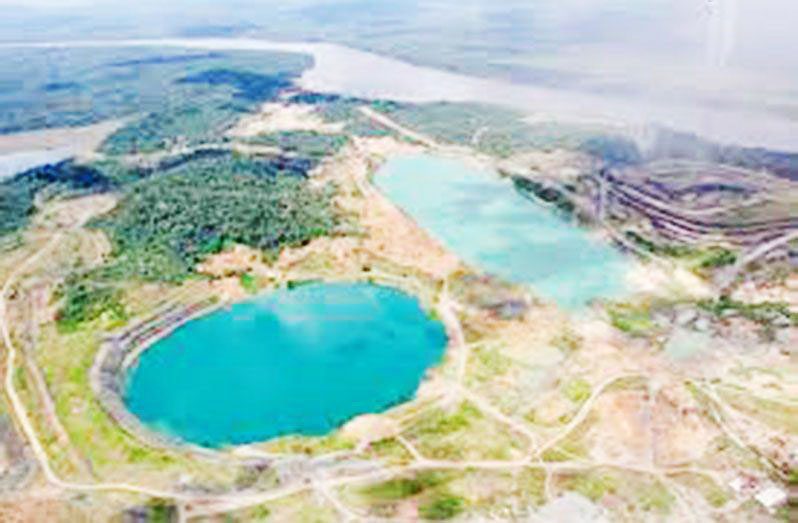OMAI Gold Mines Corporation has found more gold in Guyana, this time at its Broccoli Hill pit in Region Seven (Cuyuni-Mazaruni).
A press release from the company’s Toronto, Canada office indicated that first round of drilling at Broccoli Hill, totalling 690 metres, intersected gold mineralisation.
Commenting on the find, the company’s Chief Executive Officer, Elaine Ellingham, said that the new mineral resource is quite an achievement for the company’s first year of return to Guyana.
“We are also pleased to report that our initial trenching and drilling on Broccoli Hill that commenced late in 2021 has already resulted in several significant gold values,” Ellingham noted.
Broccoli Hill is said to be an area located only 300 metres north of the Wenot pit and less than 200 metres east of the Fennell pit. Those two pits combined, produced over 3.7 million ounces of gold.
“After field work and trenching in October and November, we completed six initial wide-spaced holes on Broccoli Hill before the holiday break in December. We intersected gold in four of the six holes and consider this very successful for first-pass drilling on a large, relatively untouched target area,” the company said in its statement.
With the knowledge gained, Omai, this week, started additional trenching, mapping and sampling.
“Over the next couple months, we will advance some of the property’s prime exploration targets, including Broccoli Hill, that hold potential for new near-surface mineralisation amenable to open pit mining,” Ellingham related.
Broccoli Hill has been worked by artisanal miners for over 100 years. Broad gold anomalies were identified by previous auger and soil surveys and the airborne geophysical signatures are similar to those of the Fennell deposit.
The abundance of past placer gold workings in the lowlands flanking the hill, together with the numerous scattered artisanal workings on the hill itself, indicate a nearby gold source, according to the company.
It noted too that exploration across this large 900 metres by 700 metres area has been hampered by a lack of knowledge of the underlying bedrock lithologies due to deep tropical weathering of the bedrock to clay-weathered saprolite to depths of 25 metres to 60 metres, complicated by transported laterite.
It was only on January 4 that Omai announced that it detected some 1.6 million ounces of gold at its Wenot Pit, located in Region Seven (Cuyuni-Mazaruni).
This discovery, according to reports, represents a significant milestone for the company which has since lost its reputation of being South America’s largest producing gold mine.
Since late November, with the Wenot mineral resource drilling completed, Omai shifted its focus to commencing exploration for near-surface mineralisation that has the potential for additional ounces amenable to open-pit mining.
Ellingham had posited with great confidence that the same Wenot exploration team will drive further exploration successes for the company, in 2022.
According to the press release: “Omai Gold Mines Corp., through its wholly owned subsidiary Avalon Gold Exploration Incorporated, holds a 100 per cent interest in the Omai Prospecting License covering 4,590 acres (18.575 sq. km) that includes the past-producing Omai gold mine, and a 100 per cent interest in the adjoining Eastern Flats Mining Permits covering 1,519 acres.”
In its prime, Omai produced over 3.7 million ounces of gold between 1993 and 2005. However, mining eventually ceased at a time when the average gold price was less than US$400 per ounce, leaving significant drilled mineral resources untapped and prime exploration targets untested.
SHORT-TERM PRIORITIES
“The company’s short-term priorities are to ensure verify and expand the known mineral resources, while advancing exploration on key targets, providing a solid opportunity to create significant value for all stakeholders,” the company had said.
It was only recently that the Guyana Chronicle reported on Omai’s intention to restart its operations with an initial investment of US$12 million.
It was reported that the company had wrapped up operations in 2015 after 24 years of service in Guyana.
With its return, the company said that, in addition to engaging and potentially supporting small miners, it also had plans to employ hundreds of people. In its earlier days, the company had in excess of 1,000 persons in its employ.
Currently, there are over 25 mining companies active in Guyana as well as large-scale oil producers like ExxonMobil, which are investing heavily in Guyana’s infrastructure and workforce.
This “economic renaissance,” as described by Omai, has led the International Monetary Fund (IMF) to rate Guyana as the fastest growing economy in the world, and determine that the country’s Gross Domestic Product (GDP) of US$3.5 billion is expected to triple within the next five years.




.png)









